August
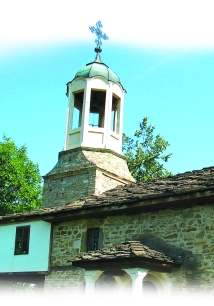 In
the ancient Roman solar calendar, the last month of
In
the ancient Roman solar calendar, the last month of
summer is the sixth month of the year and was called sextilis.
In the 1st c. BC it becomes the eighth month and by
decision of the Senate was renamed in honor of Emperor
Guy Octavian (63 BC – 14 AD), who received the title of
August (‘dignified by the gods’). This name is preserved
until now. The Bulgarians call it “glowing” month.
BRADA (‘Beard’)
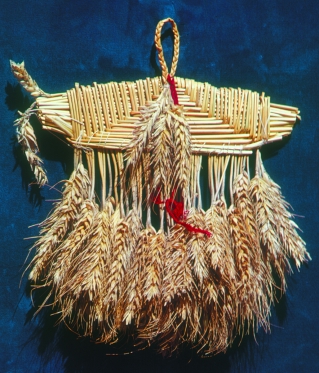
In folk mythology the beard is a symbol
of “fertile wisdom”, probably because etymologically
the word brada is a collective
and originates from the root ber/bor– meaning
‘fruit, seed’. From it derives the word
brasgno‘flour’. The same root is found in 39
names of wild plants. These are britza, the
so-called “bare wheat” (for fodder), birnitza–
wheat for bread with small grains, bosturand
barduche – plants from whose roots we can
produce flour and bread, etc. With Brada
came the end of harvest.
Early in the morning on that day the
young women leave in the fields 20-30 spikes of wheat uncut, especially
chosen for brada. After the second harvest everybody gathers round these
spikes. Young women clean them from weeds and weave the spikes in a pleat
which they tie with red thread, add field flowers, garlic against evil
eyes and a “clean coin” for prosperity. The ground round the
decorated brada is dug with the point of the sickle, fresh water is poured
and it is fed with pieces of bread in the four cardinal points. Then the
young women start singing, all people put down the sickles and start dancing
the horo. There follows a ritual washing of hands of the harvest women
and cutting of the brada, which is done by the most beautiful woman with
one cut. Then the harvesters start for their village saying goodbye to
the field: “Goodbye, field, may next year be a bigger brada, richer
crop and may we come to harvest you again!” On the way to the village
the brada is carried
by a young woman "who has a lover and will have a wedding in the
autumn", so that the future bride and the village are lucky.
1–12 August MAKAVEITE (Makaveyan Days)
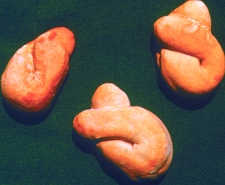 The
cycle of holidays called Makaveyan
The
cycle of holidays called Makaveyan
Days lasts for 12 days – from 1 to 12 of
August. The first day – Egus, is celebrated
mostly by women so that their fingers are
“not eaten” by spinning. On this day in some
villages the father-in-law summons his sonsin-
law to a festive table. After the meal he
taps on their back with a bag full of air. The
sons-in-law scatter into the yard and crying
out loud they walk all the corners to bring
health and fertility to the cattle. If a man works on this day, fire will
burn his house or
a wolf will eat his animals. The Makaveyan Days are related to folk meteorology.
The old Bulgarians named the days between 1 and 12 of August to the
months. The first day was September, the second was October, the third
November
and so on till the 12th day, which was again August but… next year.
Watching these 12
days, they knew what the weather would be like for a year ahead.
6 August PREOBRAZHENIE (Transfiguration)
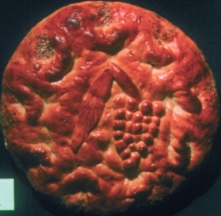 According
to folk beliefs, in the night
According
to folk beliefs, in the night
before that day the sky opens and God himself
stands in God’s doors. The one who sees
him and makes a wish, it is fulfilled. But to
see God a man must be pious. It is allowed
to have fish at table.
Bulgarians on that day pick grapes for the
first time, take it to church to sanctify it and
give it out for health and fertility during the
next year. People say that when God created
the grapes, the Devil made the blackberry,
called by the people “devil’s grapes”. The
Devil did so that it ripened earlier that the grapes. That is why nobody
eats blackberries
on Transfiguration. The good Christian tastes first the fruit of God and
only after that he
can eat blackberries without fear.
15 August GOLYAMA BOGORODITSA (Assumption)
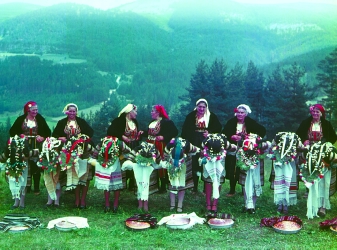 Assumption
is a big folk holiday. Nobody
Assumption
is a big folk holiday. Nobody
works. People make an offering and the sick
ones spend the night at “holy places” to get
well. For health and prosperity the first fruits,
sanctified in church, are given out – water
melons, grapes, honey.
“Till Virgin Mary’s Day straw turns into
wheat, and after Virgin Mary’s Day – the
wheat turns into straw!” Thus goes the folk
saying and the careful master must finish
threshing till Virgin Mary’s Day. Until then
every house makes a threshing-floor in the
yard and traditionally it is round so that evil
forces do not affect the house. In the middle
they set up the pillar – a thick post to which
they tie the horses during threshing. Then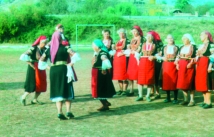
they bring the sheaves from the field and put
an unmarried young woman in the first cart
but watch that she is not in her monthly period
so that thewheat remains clean. The man
of the house fee ds the oxen with sporniche,
a herb, for fertility. The woman of the house
throws water from the well in front of the cart
with a bucket decorated with a bunch of
sweet basil, tied with a red thread, for the
wheat to flow like water on the threshingfloor. They grind of the new
wheat on Virgin
Mary’s Day. From it the ritual breads are made and it is believed
that if rain falls on
that day, the next year will be very prosperous. For the festive meal
they kill an ewe,
which is fed and incensed, like on St. George’s Day. The liver of
the animal is
boiled and brought to the church to be sanctified. The meat is prepared
on a spit on
open fire, then the neighbors exchange meat and banitsa for health, saying:
“Let Virgin
Mary help you!” In some villages the day is also celebrated for
the health of the oxen
and, as on St. Vlasius’ Day, the woman of the house decorates their
horns with buns and
feeds them ritually. Old legends advise to avoid touching anything red
on that day to
protect the cattle against bleeding and the young brides from barrenness.
The festivities
last till late at night. The nameday of Maria.
26 August. Nameday of Adrian, Adriana (the name
of a Roman general) and Natalia
(‘bybirth’).
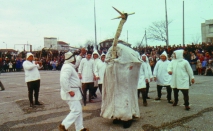 27
August. On this day in Thrace the
27
August. On this day in Thrace the
houses are visited by a summer djamalo to
bless the work of the people who have put
the grain in the barn and give them hope for
a still bigger harvest during the next year.
29 August SEKNOVENIE
(Black Saint John)
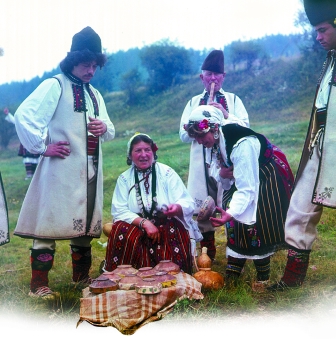 People
celebrate
People
celebrate
this day because it is “cut”, i.e. the day is
equal to the night, according to popular
belief. Water is also “cut” – it becomes colder
and people must not bathe in the open.
Aged Bulgarians of the Varna region tell the
story that on Seknovenie the snakes, the
lizards and other reptiles return to their winter
holes with the snake king. “To the end of
the world” go wood-nymphs, fairies, dragons
and dragonesses and prepare for the winter.
You must not start a new job on this day.
Women do not cut the cloth, they don’t sew
for it is believed that the dress cut or sown on
this day is “black” and brings bad luck. The
same is true of everything black and people,
if they are not in mourning, must not wear
black clothes on that day. They must not eat
black grapes in order to be healthy. So they
eat white grapes and drink white wine.